Introduction
Although, no declaration of any sort was made of Christ in early religious artistry “the text only states that in the vital instant of the cordon the godless Chagan glimpsed a number of a woman, clothed in a dignified kind, running beside the ramparts of the town walls” (Ousterhout 95). The bard connected this lady to the Virgin of the Blachernai. This image of the Blessed Virgin, the Blachernitissa, was affiliated to the maphorion (Figure 1).

The maphorion always was presumed to be the assurance for the Byzantine empires’ security as its episode in the place of adoration of the Blachernai in the 5th century; by the 7th century the image of the Virgin Blachernitissa was affiliated with mutually the maphorion and the defense of the realm (Ousterhout 95).
The Virgin Mary in Byzantine Representations
The Virgin Mary, well-known as the Theotokos in Greek expressions, was centralized to Byzantine religion as foremost important spiritual records. As the intermediary flanked by agony human being and Christ and the lady who protected the Constantinople, she was amply recognized. The Virgin symbolizes Greek songs in the praise of God, which were considered to be of importance, for signifying the Akathistos Hymn, which was created to endeavor the church festival held on the 25th of March. Account imaginative depictions of Christ’s mother objective on her starting and babyhood or her Koimesis (her Dormition, or everlasting siesta).
Most images of the Virgin stress her purpose as the mother of Jesus Christ, brandishing her status and keeping her son such as ‘The Vladimir Virgin’ (Figure 2). The sort of art in which the Virgin keeps Christ is very meticulous. Confident mimics developed into “types” that became names of refuge or rhythmical descriptions.
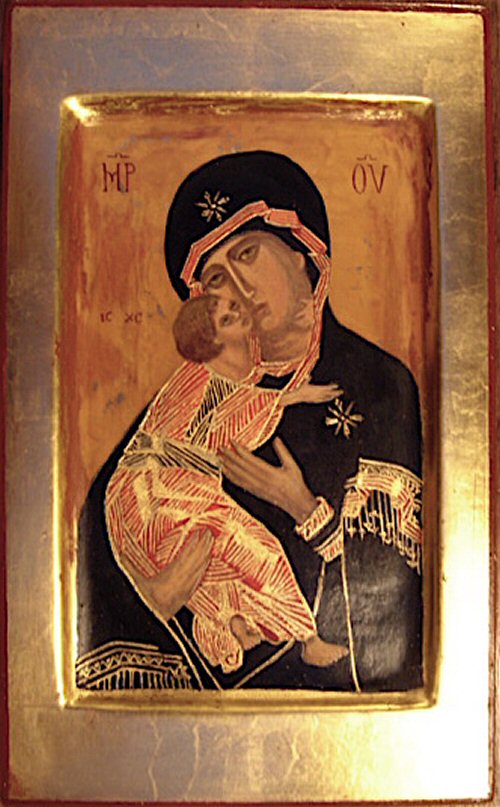
Hence, an image of the Virgin was proposed to encompass her resemblance and, at the equal instance, the imitation of a fine well-known image unique (Forsyth, 1972).
For emergence, the Virgin Hodegetria is a noise admired figure of the Virgin in which Christ is held by her in the left arm and indications in the main heading of him through her right hand, brandishing that he is the means to deliverance (Figure 3).
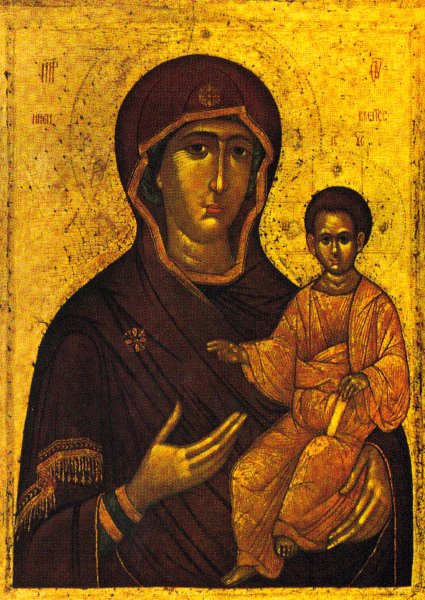
Theotokos in Greek expressions
In Constantinople, the Hodegon Monastery named it Hodegetria, where the image brandishing the Virgin in this exact position existed in even in the 12th century, depicting to fight back the city. What came to be renowned later was a type similar to that of Virgin Eleousa (Figure 4); which is pronounced to have rooted from the Virgin Hodegetria.
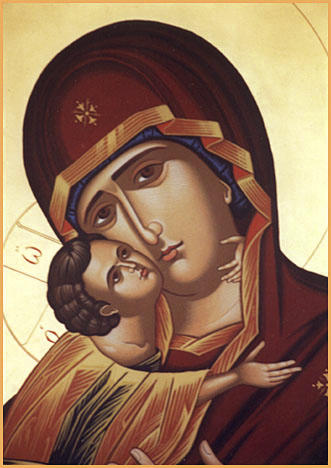
These types comprise the sympathetic for demonstration of the Virgin. She is exposed viewpoint to seem her insolence to the impudence of her offspring, who respond this liking by placing the support of his arm around her neck. Byzantine images of the Virgin were then moved on to the West (Forsyth, 1972).
Thus, as asserted by Pentcheva,
“Vestiges of the Virgin proceeded to purpose as the only entails of sign of the Virgin’s defense of Constantinople in the time span directly later than Iconoclasm. Only beginning with the middle of the 10th century … did Marian icons start to come by a public function in triumphal parades and battles. … By the second half of the eleventh 100 years, Psellos and Attaleiates record the custom of the Byzantine emperors to convey an exceptional Marian icon on infantry campaigns: the Blanchernitissa” (Ousterhout, 96).
The Virgin Mary in Western Representations
Nearly all Western types of the Virgin’s similarity, for demonstration the “Throne of Wisdom” (Figure 5) in 12th century coming from France, in which the Christ is suggested confrontationally as the supplement of heavenly knowledge, surfaced to have started in Byzantium.
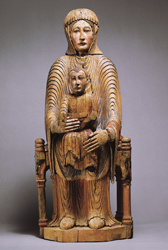
Other similar art created includes ‘The Cambrai Madonna’ (Figure 6) Byzantine types become amply distributed in Western Europe by the 7th century. The12th and 13th centuries sighted an outstanding growth of the spiritual grouping of the Virgin in Western Europe, in element inspired by the literature of Theology for demonstration.
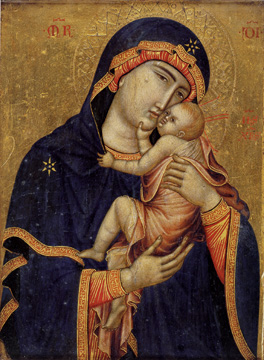
Saint Bernard of Clairvaux (Figure 7), Song of Songs in the Old Testament shows Virgin Mary being adored as Christ’s bride, personification of the Church, Heaven’s Queen and Intercessor for the deliverance of humanity (Belting, 1994).
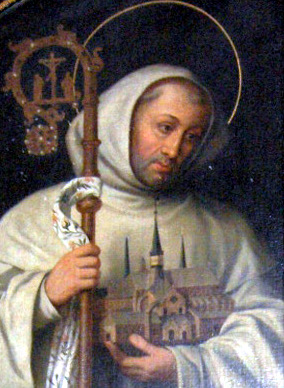
The Virgin Mary in the Later Middle Ages
This activity found out its grandest signal in the mission of France, which are frequently devoted to “Our Lady” (Figure 1) and many villages, for demonstration Siena, puts beneath her protection. Belting directs exceptional vigilance to the 13th century and to Tuscany in considering and interpreting the change of the Holy Image among East and West. “The decorating of panel crosses, altarpieces, and devotional pictures appeared in Italy in 13th Century with the aggression of an explosion….Tuscany with its increasing villages was at the forefront of the movement.” (Belting 349)
Mother of God
The hieratic photos such as the ‘Mother of the word made Flesh’ (Figure 8), of the Romanesque period, which purpose Mary’s noble characteristic, gave an approach in the Gothic age to more offer images highlighting the binding flanked by mother and child (Cormack, 1997).
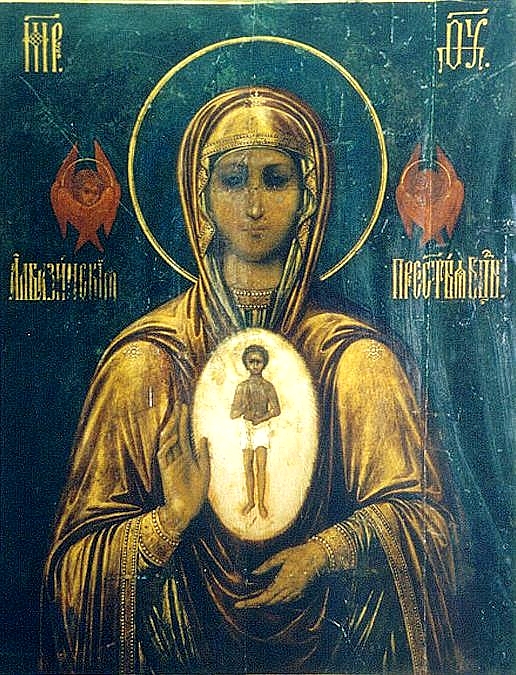
When sealed, the pivoted statue made higher of the Virgin nurturing the child Christ, any person who saves the Holy Spirit. Her piece of clothing unfastens higher, like the wings of a triptych, to divulge in her body the diagram of God the Father. He saves the pass, organized of couple tree trunks, from which the presently not existing diagram of Christ hung (Cormack, 1997).
The neighboring wings are embellished with views from Christ’s childhood or Incarnation that is to declare, the personification of God the Son in personal embodiment. This is evident especially in ‘”Tripticho” Crucifixion-Virgin Mary-Jesus Birth’ (Figure 9), which is a three fold image.
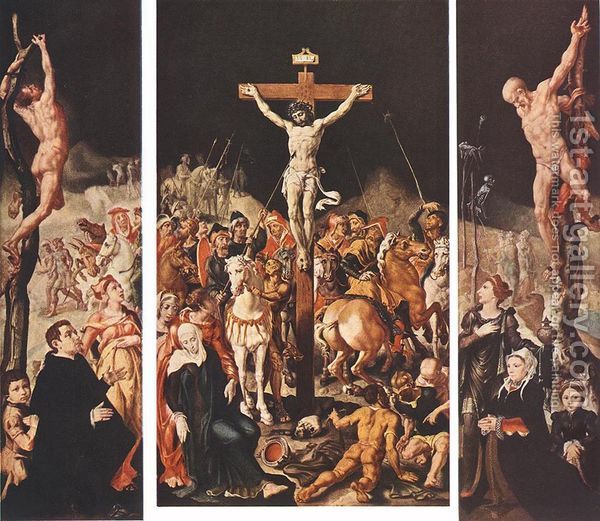
“We should habitually recall that painters were not free to invent the minutia of pictures but administered with archetypes that, more often than not, were forms in the local area accessible that had become famous, for causes conspicuous at the time but unidentified today. Painters may have disregarded the Eastern icons, which we today know to have been the factual archetypes, and intermediary forms may have profited more significance for the charge of a picture.
In its inquiring about the authorship of enduring images, art history has neglected this kind of study and has therefore tended to overestimate the individual assistance of individual painters and to underestimate the function of granted kinds, which artists duplicated other than invented.” (Belting 352)
The valued run of sensitivity in the Byzantine reaction to the Mother of God in journals, art and piety has been emphasized in a well-known paper by Ioli Kalavrezou (1990), and this statements a many trade for the appealing attribute today of icons of the Theotokos.
It was aggregated even so with a doctrinal and theological discourse of extensive complexity without which more icons were not able to be entirely expounded or appreciated. Giving due sinking implement to both these characteristics of the run of the Theotokos in Byzantium is the contest to which the providers to this size have enhanced so admirably.
Works Cited
Belting, Hans. Likeness and Presence: A History of the Image Before the Era of Art. Chicago : University of Chicago Press, 1994.
Cormack, Robin. “Women and Icons, and Women in Icons.” James, L. Women, Men and Eunuchs. Gender in Byzantium. London, 1997. 24–51, 31–8.
Forsyth, Ilene H. The Throne of Wisdom: Wood Sculptures of the Madonna in Romanesque France. Princeton: Princeton University Press, 1972.
Kalavrezou, Loli. Images of the Mother. When the Virgin Mary became Meter Theou. DOP (1990): 165–72.
Ousterhout, Robert. “The Virgin of the Chora: An Image and Its Contexts.” Brubaker, Robert Ousterhout and Leslie. The Sacred Image East and West. Urbana, IL: University of Illinois Press, 1995.